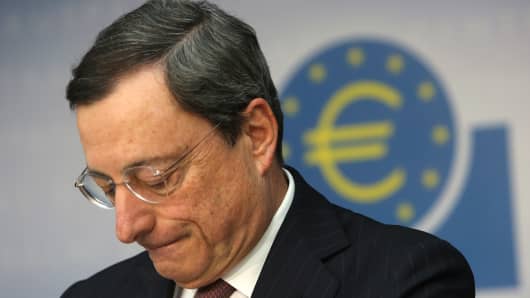Following ECB Governing Council statements in May and June that the monetary policy stance will remain accommodative for as long as necessary, on July 4, 2013 the Council took the unprecedented step of stating its expectation for future interest rates more specifically as follows:
"Looking ahead, our monetary policy stance will remain accommodative as long as necessary. The Governing Council expects the ECB interest rates to remain at present or lower levels for an extended period of time. This expectation is based on the overall subdued outlook for inflation extending into the medium term, given the broad-based weakness in the real economy and subdued monetary dynamics."
By providing information on expected future policy decisions, policy makers remove some of the uncertainty faced by market participants, namely uncertainty about the policy makers' own expectations. Accordingly, the ECB statement on future policy rates is being conditioned on its macroeconomic outlook. This conditioning is done in the same way as the ECB's usual justification of the decision on current policy rate. It includes a review of the first pillar of the ECB's strategy, its so-called economic analysis comprising the inflation and growth outlook, and the second pillar, its so-called monetary analysis or cross-checking with monetary and credit developments.
(Read more: ECB's Draghi confirms forward guidance)
The exact numerical expectation of the policy path and the length of time, for which the Governing Council anticipates policy rates to stay at current or lower levels, remain uncertain to market participants. However, President Draghi has stressed that "there is no precise deadline for this extended period of time. As a matter of fact, you can … extract a reaction function and, from there, estimate what would be a reasonable extended period of time". This is precisely what we have done here. We use a particular reaction function or interest rate rule that was shown to match past ECB interest rate decisions quite well in Orphanides and Wieland (2013), to project the rate path consistent with the macroeconomic outlook.
The rule assumes that the central bank changes the interest rate setting in response to deviations of the forecast for inflation from the central bank's target rate for inflation and to deviations of the forecast for GDP growth from the estimated growth potential. The reaction coefficients are set at 0.5 such that a one-percentage-point deviation of the inflation forecast from target or the output growth forecast from potential would result in a 50 basis point adjustment of the policy rate.
Despite its simplicity, this rule already incorporates two of the concerns mentioned by the ECB statement directly, namely the outlook for inflation and the outlook for economic activity. It could be extended to include monetary dynamics, but already matches past ECB decisions very well in its current form.
(Read more: ECB's Draghi defends interest rate guidance)
Ideally, one would want to feed in ECB Governing Council members' forecasts of inflation and output growth, but those are not publicly available. Instead we use the SPF forecast published by the ECB most recently on August 9.
Figure 1 compares the historical interest rate prescriptions from the OW rule to the ECB policy rate on its main refinancing operations (MRO Rate). The range of prescriptions spanned by the 1.5 percent and 2 percent assumptions on the inflation objective matches the ECB's interest rate decisions very well.




